
Dutch postcard by JosPe, no. 299. Photo: Clarence Sinclair Bull / Metro-Goldwyn-Mayer. Publicity still for Mata Hari (George Fitzmaurice, 1931).
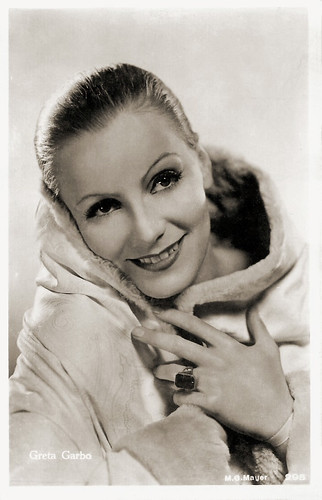
Dutch postcard by JosPe, no. 295. Photo: Metro-Goldwyn-Mayer (MGM) / Clarence Sinclair Bull. Publicity still for Mata Hari (George Fitzmaurice, 1931).
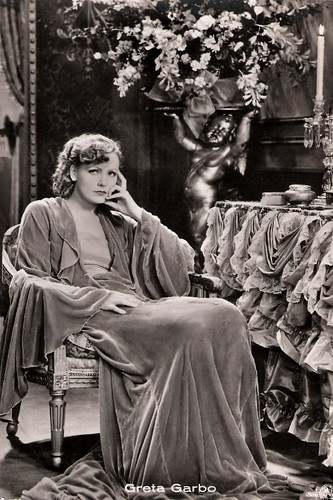
Dutch postcard. Sent by mail in 1931. Photo: Metro-Goldwyn-Mayer. Greta Garbo in Romance (Clarence Brown, 1930).

French postcard by Edition Ross, no. 5597/1, 1930-1931. Photo: Metro-Goldwyn-Mayer. Publicity still for Anna Christie (Clarence Brown, 1930).
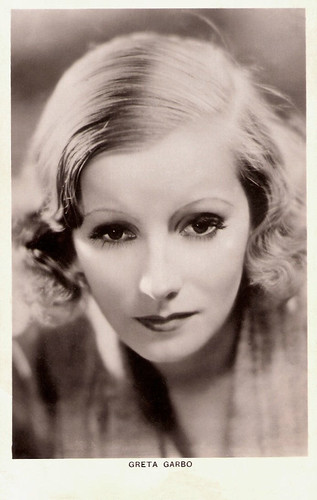
British postcard in the Picturegoer Series, London, no. 283e.
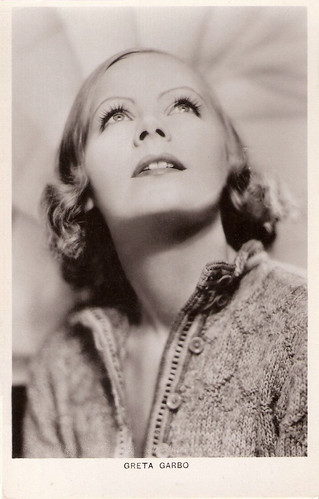
British postcard in the Picturegoer Series, London, no. 283b.
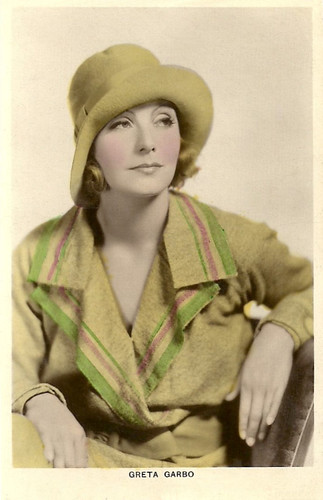
British postcard in the Colourgraph Series, London, no. C 81. Photo: publicity still for Anna Christie (Clarence Brown, 1930).

British postcard in the Valentine's Postcard series, no. 5904 F. Photo: MGM. Publicity still for Queen Christina (Rouben Mamoulian, 1933).

British postcard in the Picturegoer Series, London, no. 637b. Photo: Clarence Sinclair Bull / Metro-Goldwyn-Mayer. Publicity still for Anna Karenina (Clarence Brown, 1935).

French postcard by Ed. Chantal, no. 66. Photo: M.G.M. Publicity still for Conquest (Clarence Brown, 1937).
Garbo Talks!
In Hollywood, Greta Garbo spent most of 1925 posing for nonsensical publicity photos which endeavoured to create a 'mystery woman' image for her. Hal Erickson at AllMovie: "But it was only after shooting commenced on Garbo's first American film, The Torrent (1926), that MGM realized it had a potential gold mine on its hands." The Director of The Torrent was Monta Bell and Greta played a peasant girl turned singer opposite Ricardo Cortez. The film was a hit and despite its cool reception by the trade press, Garbo's performance was critically acclaimed.
Her third film for MGM, Flesh and the Devil (Clarence Brown, 1926), made her an international star. Her co-star was John Gilbert, and their on-screen chemistry soon translated into an off-camera romance by the end of the production, they lived together. The Garbo/Gilbert team went on to make an adaptation of Lev Tolstoy's Anna Karenina titled Love (Edmund Goulding, 1927). The couple planned to marry, but Garbo, in one of her attacks of self-imposed solitude, did not show up for the wedding. Over the years, the actress would have other romantic involvements, but would never marry.
Anna Christie (Clarence Brown, 1930) was filmed at a time of transition in Hollywood from the silent era to sound. Reportedly MGM had concerns about Garbo's voice. The studio was afraid that her thick Swedish accent would not register well in the talkies. The poster for her first sound film read "Garbo Talks!", which would become a catchphrase widely associated with her. Sixteen minutes into Anna Christie, Garbo finally utters her first, now famous line, "Gimme a whiskey, ginger ale on the side, and don't be stingy, baby." Garbo's voice meshed perfectly with her established image, and her performance in Anna Christie was effective. So, when 'Garbo talks' the audience still listened.
Anna Christie, based on a play by Eugene O'Neill, became a transitional film for Garbo. Hal Erickson: "The advent of talkies obliged the actress to drop the 'mysterious temptress' characterization she'd used in silents in favour of more richly textured performances as worldly, somewhat melancholy women to whom the normal pleasures of love and contentment would always be just out of reach."
Greta Garbo had a huge following in Europe, especially in Germany. Therefore MGM also made a German version of Anna Christie. Both versions were filmed back to back. Garbo played the leading role in both versions, but all the other characters in the German version were played by different actors from the English version. Curiously, Garbo herself supposedly favoured her Anna Christie in the German version over the English version. The German version was directed by Jacques Feyder and had its first screening in Germany in 1931.

Dutch postcard by JosPe, Arnhem, no. 34. Photo: Clarence Sinclair Bull / Metro Goldwyn Mayer. Publicity still for Anna Christie (Clarence Brown, 1930).

Dutch Postcard, no. 41. Photo: Clarence Sinclair Bull / Metro Goldwyn Mayer. Publicity still for Anna Christie (Clarence Brown, 1930).
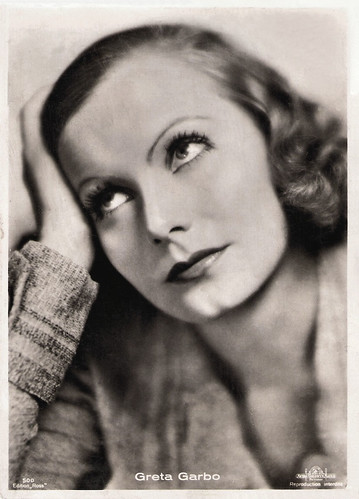
French postcard by Edition Ross, no. 500. Photo: Clarence Sinclair Bull. Publicity still for the German version of Anna Christie (Jacques Feyder, 1930).

German postcard by Ross Verlag, no. 5513/2, 1930-1931. Photo: MGM. Photo: Clarence Sinclair Bull. Publicity still for the German version of Anna Christie (Jacques Feyder, 1930).
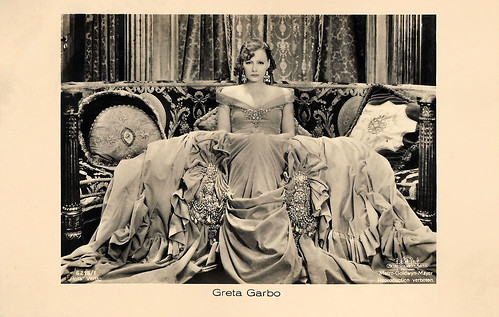
German postcard by Ross Verlag, no. 6215/1, 1931-1932. Photo: George Hurrell / Metro-Goldwyn-Mayer. Greta Garbo in an over-the-top dress by Adrian in Romance (Clarence Brown, 1930). Set by Cedric Gibbons.
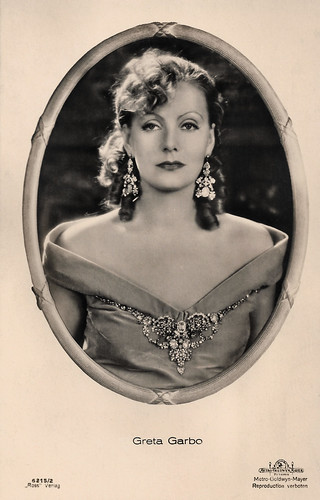
German postcard by Ross Verlag, no. 6215/2, 1931-1932. Photo: George Hurrell / Metro-Goldwyn-Mayer. Greta Garbo in Romance (Clarence Brown, 1930).
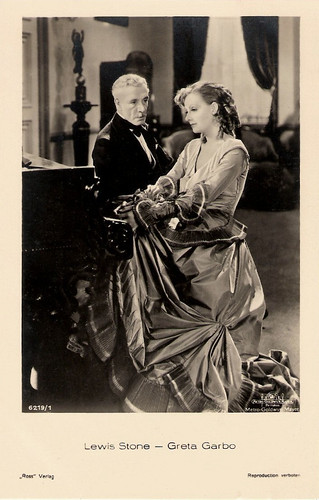
German postcard by Ross Verlag, no. 6219/1, 1931-1932. Photo: Metro-Goldwyn-Mayer (MGM). Greta Garbo and Lewis Stone in Romance (Clarence Brown, 1930).

Italian postcard by Cinema-Illustrazione, Milano, series II, no. 1. Photo: Metro-Goldwyn-Mayer. Greta Garbo and Gavin Gordon acted together in the early sound film Romance (Clarence Brown, 1930). It was also issued as a silent film.

Italian postcard by Cinema-Illustrazione, Milano, series 2, no. 3. Photo: Metro-Goldwyn-Mayer. Greta Garbo and Robert Montgomery in Inspiration (Clarence Brown, 1931).

German postcard by Ross Verlag, no. 5924/2, 1930-1931. Photo:Clarence Sinclair Bull / Metro-Goldwyn-Mayer. Publicity still for Inspiration (Clarence Brown, 1931).
From the Greatest Money-making Machine to Box Office Poison
Greta Garbo next made Romance (Clarence Brown, 1930) in the same year as Anna Christie. Romance is a film with nearly no plot twists, but Garbo is stunning. She originally wanted Gary Cooper as her leading man, but MGM could not borrow Cooper from Paramount, so Garbo had to settle for Lewis Stone and the unknown Gavin Gordon. After Anna Christie, Romance (1930) was somewhat of a letdown, but for her performances in these films, she received the first of three Academy Award nominations for Best Actress. Academy rules at the time allowed for a performer to receive a single nomination for their work in more than one film.
In 1931, Garbo bounced back, landing another lead role opposite Ramon Novarro as the World War I spy in Mata Hari (George Fitzmaurice, 1931). The lavish production turned out to be a major hit. The next year she was cast in yet another hit, Grand Hotel (Edmund Goulding, 1932). She played a Russian ballerina opposite an ensemble cast, including John Barrymore, Joan Crawford, and Wallace Beery. The film won an Academy Award for Best Picture. Both Mata Hari and Grand Hotel had been MGM's highest-earning films of 1931 and 1932, respectively, and Garbo was dubbed "the greatest money-making machine ever put on screen".
From now on, her popularity allowed her to dictate the terms of her contract and Garbo became increasingly selective about her roles. Queen Christina (Rouben Mamoulian, 1933) was a lavish production, becoming one of the studio's biggest productions at the time. Publicised as 'Garbo Returns', the film became the highest-grossing film of the year. However, censors objected to the scenes in which Garbo disguised herself as a man and kissed a female co-star.
In the Leo Tolstoy adaptation Anna Karenina (Clarence Brown, 1935), she played another of her renowned roles. The film won the Mussolini Cup for the best foreign film at the Venice Film Festival, and Garbo received a New York Film Critics Circle Award for Best Actress for her role as Anna. Many critics and film historians consider her performance as the doomed courtesan Marguerite Gautier in George Cukor's romantic drama Camille (1936) to be her finest. The role gained her a second Academy Award nomination.
However, Greta Garbo's career soon declined after the flop Conquest (Clarence Brown, 1937), and in 1938, she was one of the many stars labelled 'Box Office Poison'.

German postcard by Ross Verlag, no. 140/2. Greta Garbo and Clark Gable in Susan Lenox (Her Fall and Rise) (Robert Z. Leonard, 1931). Susan Lenox (Her Fall and Rise) was released in German-speaking countries as 'Helga's Fall und Aufstieg'. Her character's name is really Helga Ohlin, she only later changes it to Susan Lenox.

German postcard by Ross Verlag, no. 6213/1, 1931-1932. Photo: Photo: Clarence Bull / Metro-Goldwyn-Mayer. Publicity still for Susan Lenox, Her Fall and Rise (Robert Z. Leonard, 1931).
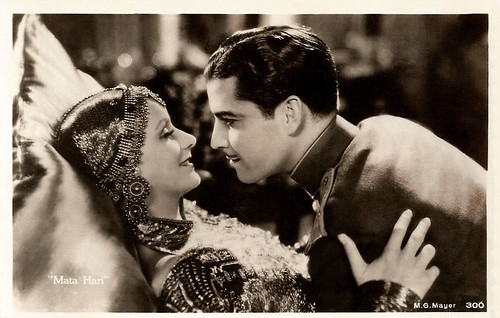
Vintage postcard, no. 300. Photo: M.G.Mayer. Publicity still for Mata Hari (George Fitzmaurice, 1931) with Ramon Novarro.

German postcard by Ross Verlag, no. 6521/2, 1931-1932. Photo: Clarence Sinclair Bull / Metro-Goldwyn-Mayer. Publicity still for Mata Hari (George Fitzmaurice, 1931).

German postcard by Ross Verlag, Berlin, no. 139/3. Photo: Metro-Goldwyn-Mayer. Greta Garbo, Ramon Novarro, and Lionel Barrymore in Mata Hari (George Fitzmaurice, 1931).

Postcard with Dutch censorship stamp, no. 359. Photo: publicity still for Grand Hotel (Edmund Goulding, 1932) with Ferdinand Gottschalk and Rafaela Ottiano.

German postcard by Ross Verlag, no. 6389/2, 1931-1932. Photo: Metro-Goldwyn-Mayer. Greta Garbo in Grand Hotel (Edmund Goulding, 1932).

German postcard by Ross Verlag, no. 186/3. Photo: Metro-Goldwyn-Mayer. Erich von Stroheim and Greta Garbo in As You Desire me (George Fitzmaurice, 1932).

German postcard by Ross Verlag, no. 7802/1, 1932-1933. Photo: Clarence Sinclair Bull / Metro-Goldwyn-Mayer. Publicity still for As You Desire Me (George Fitzmaurice, 1932).
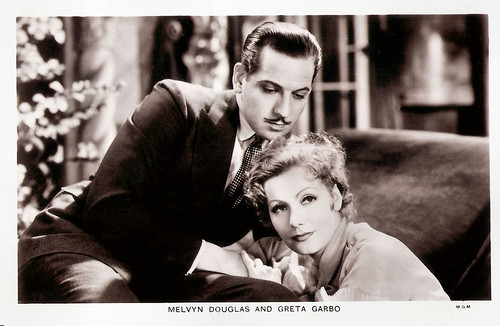
British postcard in the Film Partners series, no. P 82. Photo: MGM. Greta Garbo and Melvyn Douglas in As You Desire Me (George Fitzmaurice, 1932).
Garbo laughs!
In 1939, Greta Garbo made a comeback when she starred in Ninotchka (Ernst Lubitsch, 1939). Her first comedy was one of the first Hollywood films which, under the cover of a satirical, light romance, depicted the Soviet Union under Joseph Stalin as being rigid and grey when compared to its prewar years. Ninotchka was publicised with the catchphrase 'Garbo laughs!', commenting on the departure of Garbo's serious and melancholy image as she transferred to comedy. Bosley Crowther, the famous New York Times film critic wrote that Garbo Garbo "demonstrated that she had the wit and flexibility to be a fine comedienne".
All of Garbo's films were in black and white which enhanced her mystery and romantic allure. Her last film was the domestic comedy Two-Faced Woman (George Cukor, 1941), which was considered a distinct step downward for her. The film drew controversy and was condemned by the Catholic Church and other groups and was a box office failure. She was 35 and had acted in twenty-eight films.
After the war, Greta Garbo hoped to return to films. She was asked to appear in Alfred Hitchcock's The Paradine Case (1947), but she turned the role down. In 1949, after making some screentests for a film project called The Wicked Dutchess which was never realised due to financial problems, Garbo retired definitively. Greta Garbo abandoned Hollywood and moved to New York City. She would jet-set with such personalities as Aristotle Onassis and Cecil Beaton, and spend the rest of her time gardening flowers and vegetables.
In the 1970s, Garbo travelled less and grew more and more eccentric, although she still took daily walks through Central Park with close friends. In the late 1980s failing health decreased her mobility. In her final year, it was her family that cared for her, including taking her to dialysis treatments.
In 1990, Greta Garbo died of natural causes in New York. She was 84. In 1954, she was given a special Oscar 'for her unforgettable performances', and in 1999, the American Film Institute ranked Garbo fifth on their list of the greatest female stars of classic Hollywood cinema, after Katharine Hepburn, Bette Davis, Audrey Hepburn, and Ingrid Bergman. Hal Erickson at AllMovie: "Even after her death in 1990, the legend of Greta Garbo was undiminished. Few of her fans talk of her in human terms; to her devotees, Greta Garbo was not so much film legend as film goddess."

Dutch postcard, no. 591. Photo: Clarence Sinclair Bull / Metro-Goldwyn-Mayer. Greta Garbo in Queen Christina (Rouben Mamoulian, 1933).

German postcard by Ross Verlag, no. 194/3. Photo: MGM. Greta Garbo and John Gilbert in Queen Christina (Rouben Mamoulian, 1933).

German postcard by Ross Verlag, no. 8341/1, 1933-1934. Photo: Clarence Sinclair Bull / Metro-Goldwyn-Mayer. Greta Garbo in Queen Christina (Rouben Mamoulian, 1933).

British postcard. Greta Garbo as Kitty Fane in The Painted Veil (Richard Boleslawski, 1934). Metro-Goldwyn-Mayer.

German postcard by Ross Verlag, no. 9311/2, 1935-1936. Photo: Clarence Sinclair Bull / Metro-Goldwyn-Mayer. Greta Garbo in Anna Karenina (Clarence Brown 1935).

German postcard by Ross Verlag, no. 9313/1, 1935-1936. Photo: Metro-Goldwyn-Mayer. Greta Garbo and Fredric March in Anna Karenina (Clarence Brown 1935).

Italian postcard by B.F.F. Edit., no. 3616. Photo: Clarence Sinclair Bull / Metro-Goldwyn-Mayer. Publicity still for Camille (George Cukor, 1936).

German postcard by Ross Verlag, no. A 1330/1, 1937-1938, Photo: Metro-Goldwyn-Mayer. Greta Garbo and Robert Taylor in Camille (George Cukor, 1936).

German postcard by Ross Verlag, no. A 1424/3, 1937-1938. Photo: Metro-Goldwyn-Mayer. Greta Garbo in Conquest (Clarence Brown, 1937).

German postcard by Ross Verlag, no. A 1756/2, 1937-1938. Photo: Metro Goldwyn Mayer. Greta Garbo and Scotty Beckett in Conquest / Marie Walewska (Clarence Brown, 1937).

Italian postcard by B.F.F. Edit. (Casa Editr. Ballerini & Fratini, Firenze), no. 2178. Photo: Metro-Goldwyn-Mayer. Greta Garbo in Ninotchka (Ernst Lubitsch, 1939).
Sources: Hal Erickson (AllMovie), Denny Jackson (IMDb), Wikipedia, and IMDb.
This post was last updated on 3 May 2024.
2 comments:
Just wonder how much of European Film Star Postcards you have in your collection :)
Stay tuned to your updates.
Thank you. Please allow me to return later.
Greta Garbo
Post a Comment